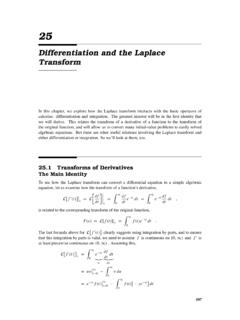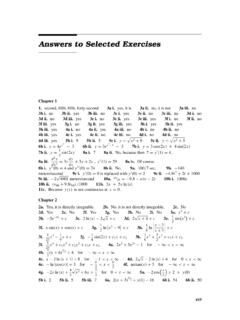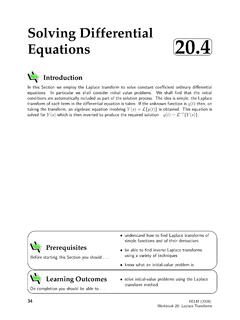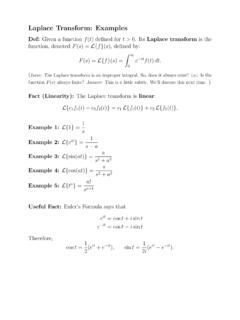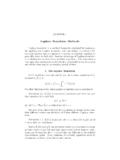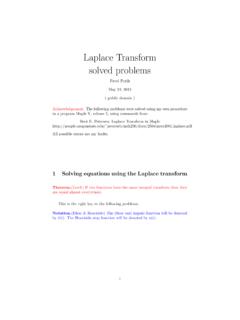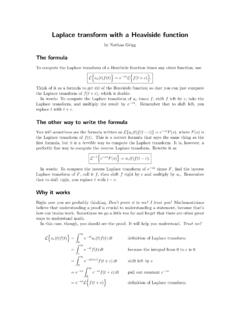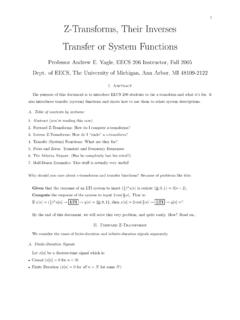Transcription of The Inverse Laplace Transform
1 26 The Inverse Laplace TransformWe now know how to find Laplace transforms of unknown functions satisfying various initial-value problems. Of course, it s not the transforms of those unknown function which are usuallyof interest. It s the functions, themselves, that are of interest. So let us turn to the general issueof finding a functiony(t)when all we know is its Laplace transformY(s). Basic NotionsOn Recovering a Function from Its TransformIn attempting to solve the differential equation in , we gotY(s)=4s 3,which, sinceY(s)=L[y(t)]|sand4s 3=L[4e3t] s,we rewrote asL[y(t)]=L[4e3t].From this, seemed reasonable to conclude thaty(t)= , what if there were another functionf(t)with the same Transform as 4e3t? Then we couldnot be sure whether the abovey(t)should be 4e3tor that other functionf(t). Fortunately,someone has managed to prove the following:Theorem (uniqueness of the transforms)Supposefandgare any two piecewise continuous functions on[0, )of exponential orderand having the same Laplace transforms,L[f]=L[g].]
2 Then, as piecewise continuous functions,f(t)=g(t)on[0, ).527528 The Inverse Laplace Transform (You may want to quickly review the discussion of equality of piecewise continuous func-tions on page 497.)This theorem actually follows from another result that willbe briefly discussed at the endof this section. What is important, now, is that this theoremassures us that, ifL[y(t)]|s=L[4e3t] s,theny(t)=4e3t,at least fort 0 .What about fort<0 ? Well, keep in mind that the Laplace Transform of any functionf,F(s)=L[f]|s= 0f(t)e stdt,involves integration only over the positiveT axis. The behavior offon the negativeT axishas no effect on the formula forF(s). In fact,f(t)need not even be defined fort<0 . So,even if they exist, there can be no way to recover the values off(t)on the negativeT axis fromF(s). But that is not a real concern because we will just use the Laplace Transform for problemsover the positiveT axis problems in which we have initial values att=0 and want to knowwhat all this means is that we are only interested in functions oftwitht 0.]
3 That washinted at when we began our discussions of the Laplace Transform (see note 3 on page 477), butwe did not make an issue of it to avoid getting too distracted by technical details. Now, with theinverse Transform , requiringt 0 becomes more of an issue. Still, there is no need to obsessabout this any more than necessary, or to suddenly start including fort 0 with everyformula oft. Let us just agree that the negativeT axis is irrelevant to our discussions, and thatin all formulas involvingt, it is assumed thatt 0 .! Example :Somewhere above, we havey(t)= we really mean is thaty(t)=4e3tfort have no idea whaty(t)is fort<0. We don t even know whether, in whatever applicationthis may have arisen, it makes sense to talk abouty(t)fort<0, nor do we Inverse Laplace Transform DefinedWe can now officially define the Inverse Laplace Transform :Given a functionF(s), theinverse Laplace Transform of F, denoted byL 1[F],is that functionfwhose Laplace Transform example: What ify(t)denoted the temperature in a cup of coffeetminutes after being poured?
4 Does it makesense to consider the temperature of the coffee before it exists? (Answer this assuming you are not a Zen master.)Basic Notions529 More succinctly:f(t)=L 1[F(s)]|t L[f(t)]|s=F(s).Our theorem on uniqueness (theorem ) (along with our understanding about always assum-ingt 0 ) assures us that the above definition forL 1[F]is unambiguous. In this definition,of course, we assumeF(s)can be given asL[f(t)]for some functionf.! Example :We haveL 1[4s 3] t=4e3tbecause4s 3=L[4e3t] , sinceL[t3] s=6s4,we havet3=L 1[6s4] fact thatf(t)=L 1[F(s)]|t L[f(t)]|s=F(s)means that any table of Laplace transforms (such as table on page 484) is also a table ofinverse Laplace transforms. Instead of reading off theF(s)for eachf(t)found, read off thef(t)for eachF(s).As you may have already noticed, we take Inverse transforms of functions ofsthat aredenoted by upper case Roman letters and obtain functions oftthat are denoted by the cor-responding lower case Roman letter . These notational conventions are consistent with thenotational conventions laid down earlier for the Laplace should also note that the phrase Inverse Laplace Transform can refer to either the Inverse transformed function for to the process of the way, there is a formula for computing Inverse Laplace transforms.
5 If you must know,it isL 1[F(s)]|t=12 limY + Y Yet( +i )F( +i )d .The integral here is over a line in the complex plane, and is a suitably chosen positive deriving this formula, you actually verify uniqueness theorem Unfortunately, derivingand verifying this formula goes beyond our current t pretend to understand this formula, and don t try to use it until you ve had a course incomplex variables. Besides, it is not nearly as useful as a good table of derivations can be found in third edition ofTransforms and Applications Handbook(Ed: A. Poularikas,CRC Press). One, using Fourier transforms, is in section of the chapter on Fourier transforms by other, using results from the theory of complex analyticfunctions, is in section of the chapter on Laplacetransforms by Poularikas and Inverse Laplace Linearity and Using Partial FractionsLinearity of the Inverse TransformThe fact that the Inverse Laplace Transform is linear follows immediately from the linearity ofthe Laplace Transform .
6 To see that, let us considerL 1[ F(s)+ G(s)]where and areany two constants andFandGare any two functions for which Inverse Laplace transformsexist. Following our conventions, we ll denote those Inverse transforms byfandg. That is,f(t)=L 1[F(s)]|tandg(t)=L 1[G(s)]| , this is completely the same as stating thatL[f(t)]|s=F(s)andL[g(t)]|s=G(s).Beca use we already know the Laplace Transform is linear, we knowL[ f(t)+ g(t)]|s= L[f(t)]|s+ L[g(t)]|s= F(s)+ G(s).This, along the definition of the Inverse Transform and the above definitions offandg, yieldsL 1[ F(s)+ G(s)]|t= f(t)+ g(t)= L 1[F(s)]|t+ L 1[G(s)]| these little computations with as many functions and constants as desired then gives usthe next theorem:Theorem (linearity of the Inverse Laplace Transform )The Inverse Laplace Transform Transform is linear. That is,L 1[c1F1(s)+c2F2(s)+ +cnFn(s)]=c1L 1[F1(s)]+c2L[F2(s)]+ +cnL[Fn(s)]when eachckis a constant and eachFkis a function having an Inverse Laplace s now use the linearity to compute a few Inverse transforms.
7 ! Example :Let s findL 1[1s2+9] know (or found in table on page 484) thatL 1[3s2+9] t=sin(3t),which is almost what we want. To use this in computing our desired Inverse Transform , wewill combine linearity with one of mathematics oldest tricks (multiplying by1with, in thiscase,1=3/3):L 1[1s2+9] t=L 1[13 3s2+9] t=13L 1[3s2+9] t=13sin(3t).Linearity and Using Partial Fractions531 The use of linearity along with multiplying by 1 will be used again and again. Get usedto it.! Example :Let s find the Inverse Laplace Transform of30s7+8s knowL 1[6!s7] t=t6andL 1[1s 4] t= ,L 1[30s7+8s 4] t=30L 1[1s7] t+8L 1[1s 4] t=30L 1[16! 6!s7] t+8e4t=306!L 1[6!s7] t+8e4t=306 5 4 3 2t6+8e4t,which, after a little arithmetic, reduces toL 1[30s7+8s 4] t=124t6+ FractionsWhen using the Laplace Transform with differential equations, we often get transforms that canbe converted via partial fractions to forms that are easily Inverse transformed using the tablesand linearity, as above.
8 This means that the general method(s) of partial fractions are particularlyimportant. By now, you should well-acquainted with using partial fractions remember, thebasic idea is that, if we have a fraction of two polynomialsQ(s)P(s)andP(s)can be factored into two smaller polynomialsP(s)=P1(s)P2(s),then two other polynomialsQ1(s)andQ2(s)can be found so thatQ(s)P(s)=Q(s)P1(s)P2(s)=Q1(s)P1(s)+Q 2(s)P2(s).Moreover, if (as will usually be the case for us) the degree ofQ(s)is less than the degree ofP(s), then the degree of eachQk(s)will be less than the degree of the correspondingPk(s).You probably used partial fractions to compute some of the integrals in the earlier chaptersof this text. We ll go through a few examples to both refresh our memories of this technique,and to see how it naturally arises in using the Laplace Transform to solve differential Inverse Laplace Transform ! Example :In exercise e on page 523, you found that the Laplace Transform of thesolution toy +4y=20e4twithy(0)=3andy (0)=12isY(s)=3s2 28(s 4)(s2+4).
9 The partial fraction expansion of this isY(s)=3s2 28(s 4)(s2+4)=As 4+Bs+Cs2+4for some constantsA,BandC. There are many ways to find these constants. The basicmethod is to undo the partial fraction expansion by getting a common denominator andadding up the fractions on the right:3s2 28(s 4)(s2+4)=As 4+Bs+Cs2+4=A(s2+4)(s 4)(s2+4)+(s 4)(Bs+C)(s 4)(s2+4)= =(A+B)s2+(C 4B)s+4(A C)(s 4)(s2+4).Cutting out the middle and canceling out the common denominator leads to the equation3 s2+0 s 28=(A+B)s2+(C 4B)s+4(A C),which, in turn, means that our constants satisfy the three bythree system3=A+B0=C 4B 28=4A is relatively simple system. Solving it however you wish, you obtainA=1andB=2andC= (s)=As 4+Bs+Cs2+4=1s 4+2s+8s2+4,andy(t)=L 1[Y(s)]|t=L 1[1s 4+2s+8s2+4] t=L 1[1s 4] t+2L 1[ss2+4] t+8L 1[1s2+4] t=e4t+2L 1[ss2+22] t+8 12L 1[2s2+22] t=e4t+2 cos(2t)+4 sin(2t).Linearity and Using Partial Fractions533! Example :In example on page 511 we obtainedY(s)=16(s 2)(s2 7s+12)+6s 38s2 7s+12and, equivalently,Y(s)=6s2 50s+92(s 2)(s2 7s+12)as the Laplace Transform of the solution to some initial-value problem.
10 While we could findpartial fraction expansions for each term of the first expression above, it will certainly be moreconvenient to simply find the single partial fraction expansion for the second expression forY(s). But before attempting that, we should note that one factor in the denominator can befurther factored,s2 7s+12=(s 3)(s 4),giving usY(s)=6s2 50s+92(s 2)(s 3)(s 4).Now we can seek the partial fraction expansion ofY(s):6s2 50s+92(s 2)(s 3)(s 4)=As 2+Bs 3+Cs 4= =A(s 3)(s 4)+B(s 2)(s 4)+C(s 2)(s 3)(s 2)(s 3)(s 4).Cutting out the middle and canceling out the common denominator leaves6s2 50s+92=A(s 3)(s 4)+B(s 2)(s 4)+C(s 2)(s 3).( )Rather than multiplying out the right side of this equation and setting up the system thatA,BandCmust satisfy for this equation to hold (as we did in the previous example), let s findthese constants after making clever choices for the value ofsin this last equation ( ):6(22) 50 2+92=A(2 3)(2 4)+B(2 2)(2 4)+C(2 2)(2 3) 16=2A+0B+0CH A= equation ( ):6(32) 50 3+92=A(3 3)(3 4)+B(3 2)(3 4)+C(3 2)(3 3) 4=0A B+0CH B= Inverse Laplace TransformLettings=4in equation ( ):6(42) 50 4+92=A(4 3)(4 4)+B(4 2)(4 4)+C(4 2)(4 3) 12=0A+0B+2CH C= the above results, we haveY(s)=6s2 50s+76(s 2)(s 3)(s 4)=As 2+Bs 3+Cs 4=8s 2+4s 3 6s ,y(t)=L 1[Y(s)]|t=L 1[8s 2+4s 3 6s 4] t=8L 1[1s 2] t+4L 1[1s 3] t 6L 1[1s 4] t=8e2t+4e3t recall how to deal with repeated factors in the denominator.
